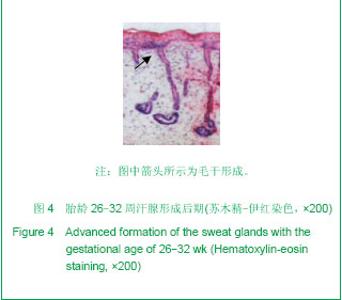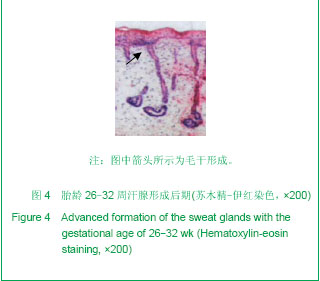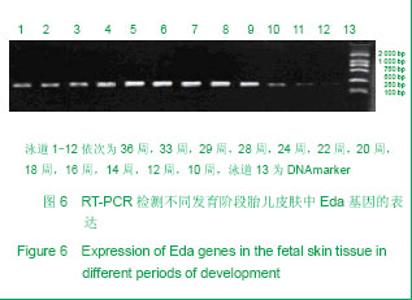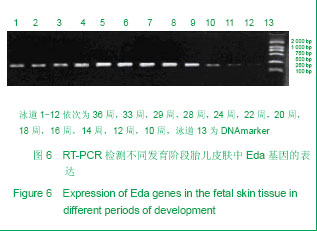Chinese Journal of Tissue Engineering Research ›› 2013, Vol. 17 ›› Issue (24): 4421-4428.doi: 10.3969/j.issn.2095-4344.2013.24.008
Previous Articles Next Articles
Gene expression of the skin and sweat glands in different development stages of embryo
Chen Li-ying1, Fan Kun-wu1, Wang Jin-shui2, Yu Xu-ming1, Xu Cheng1
- 1 Department of Burns and Plastic Surgery, the Second People’s Hospital of Shenzhen, Shenzhen 518000, Guangdong Province, China
2 PKU Shenzhen Wuzhou Pharmaceutical Co., Ltd., Shenzhen 518000, Guangdong Province, China
-
Received:2012-11-11Revised:2013-02-04Online:2013-06-11Published:2013-06-11 -
Contact:Fan Kun-wu, Master, Chief physician, Department of Burns and Plastic Surgery, the Second People’s Hospital of Shenzhen, Shenzhen 518000, Guangdong Province, China fankunwu@hotmail.com -
About author:Chen Li-ying, Associate chief physician, Department of Burns and Plastic Surgery, the Second People’s Hospital of Shenzhen, Shenzhen 518000, Guangdong Province, China 624192754@qq.com
CLC Number:
Cite this article
Chen Li-ying, Fan Kun-wu, Wang Jin-shui, Yu Xu-ming, Xu Cheng. Gene expression of the skin and sweat glands in different development stages of embryo[J]. Chinese Journal of Tissue Engineering Research, 2013, 17(24): 4421-4428.
share this article
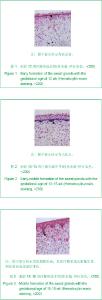
2.1 不同发育阶段胎儿皮肤及附属汗腺的生物学特征 光镜下可见不同发育阶段的人类胚胎胎儿皮肤具有特殊的组织学结构,汗腺在胚胎期E10周首先于手足掌部开始发育,外观上表皮嵴中基底细胞呈树枝状向真皮方向延伸,这时表皮含有较多的脂类物质,仅由一二层细胞组成空泡状的周皮,周皮基底层细胞排列疏松且尚未形成极性细胞。 E12周后表皮基底层细胞开始充盈饱满并逐渐呈栏栅状排列,表皮嵴形成,毛囊的原基开始出现,外观形态呈相间分布的细胞团,间质细胞包绕其周围,见图1。 E13-15周皮肤表皮基底层向上已经比E10周多了1倍的细胞层组成,达2-4层,排列仍然无层次,毛乳头开始形成,见图2,相间出现的汗腺原基明显发育的比E10周更成熟。 E15-18周空泡状的周皮细胞开始脱落,皮下脂肪组织开始形成,表皮和真皮层均增厚,皮脂腺形成,足底汗腺原基内细胞呈条树枝状向真皮深层生长,见图3。"

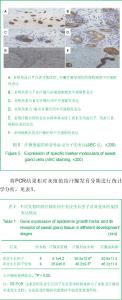
2.2 汗腺细胞中角蛋白的表达 根据皮肤汗腺结构形成的时序大致划分为汗腺形成初期(胚芽或原基期)、汗腺形成中期和汗腺成熟期;胎儿汗腺细胞能用角蛋白7、角蛋白8、角蛋白18和癌胚抗原等生物分子标记。角蛋白7、角蛋白8、角蛋白18和癌胚抗原只在皮肤组织内的汗腺细胞中表达,而在真皮层和表皮层的其他细胞呈阴性反应,见图5。 2.3 RT-PCR检测不同发育阶段人胎儿皮肤及附属汗腺的基因表达 表皮生长因子和表皮生长因子受体的mNRA经过RT-PCR扩增后,得到特异性的DNA片段分别由149 bp和168 bp组成。RT-PCR结果显示表皮生长因子基因在胚芽期即有表达,随着胎龄的增加,表皮生长因子的表达量总体呈高水平趋势;而表皮生长因子受体基因的表达量稍稍滞后,且其表达量增幅最快是在汗腺形成初期和中期,成熟期表皮生长因子及其受体的基因则持续表达,见表1。"
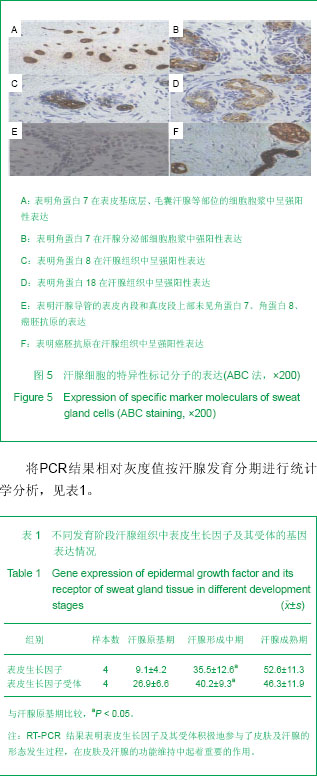
| [1] Hu HW. Nanjing:Southeast University Press, 2009.胡捍卫.组织胚胎学[M].2版.东南大学出版社,2009.http://www.seupress.com/book.details.php?id=2603[2] Aberdam D. Epidermal stem cell fate: what can we learn from embryonic stem cells. Cell Tissue Res. 2008;331(1):103-107.http://www.ncbi.nlm.nih.gov/pubmed?term=Epidermal%20stem%20cell%20fate%3A%20what%20can%20we%20learn%20from%20embryonic%20stem%20cells[3] Li HH,Fu XB,Zhou G,et al. Zhonghua Yixue Zazhi. 2005;85(27):1885-1889.李海红,付小兵,周岗,等. 人骨髓间充质干细胞与汗腺细胞共同培养诱导细胞表型转化的初步研究[J]. 中华医学杂志, 2005,85(27):1885-1889.http://so.med.wanfangdata.com.cn/ViewHTML/PeriodicalPaper_zhyx200527006.aspx[4] Xu LQ,Sui J,Ding Y,et al. Zhongguo Zuzhi Gongcheng Yanjiu yu Linchuang Kangfu. 2007;11(7):1243-1246.徐龙强, 隋静,丁钰, 等. 大鼠骨髓间充质干细胞体外培养转化为神经细胞的实验[J]. 中国组织工程研究与临床康复, 2007,11(7):1243-1246.http://so.med.wanfangdata.com.cn/ViewHTML/PeriodicalPaper_xdkf200707011.aspx[5] Li HH, Zhou G, Fu XB,et al. Antigen expression of human eccrine sweat glands. J Cutan Pathol. 2009;36(3):318-324. http://www.ncbi.nlm.nih.gov/pubmed/19032382[6] Zeng B, Chen H, Zhu C, et al. Effects of combined mesenchymal stem cells and heme oxygenase-1 therapy on cardiac performance. Eur J Cardiothorac Surg. 2008;34(4):850-856. http://www.ncbi.nlm.nih.gov/pubmed?term=Effects%20of%20combined%20mesenchymal%20stem%20cells%20and%20heme%20oxygenase-1therapy%20on%20cardiac%20performance[7]Zhou G,Fu XB. Chuangshang Waike Zazhi. 2005;7(5):394-396.周岗,付小兵.汗腺中EGF、EGFR、IL和CKs等基因的表达特征及意义[J].创伤外科杂志, 2005,7(5):394-396. http://so.med.wanfangdata.com.cn/ViewHTML/PeriodicalPaper_cswkzz200505033.aspx[8] Zhuang Y, Chen X, Xu M, et al. Chemokine stromal cell-derived factor 1/CXCL12 increases homing of mesenchymal stem cells to injured myocardium and neovascularization following myocardial infarction.Chin Med J (Engl). 2009;122(2):183-187.http://www.ncbi.nlm.nih.gov/pubmed?term=Chemo%20kine%20stromal%20cell-derived%20factor1%2FCXCL12increases%20homing%20of%20mesenchymal%20stem%20cells%20to%20injured%20myocardium%20and%20neovascularization%20following%20myocardial%20infarction[9] Sheng Z, Fu X, Cai S,et al. Regeneration of functional sweat gland-like structures by transplanted differentiated bone marrow mesenchymal stem cells.Wound Repair Regen. 2009;17(3):427-435.http://www.ncbi.nlm.nih.gov/pubmed?term=Regeneration%20of%20functional%20sweat%20gland-like%20structures%20by%20transplanted%20differentiated%20bone%20marrow%20mesenchymal%20stem%20cells[10] Zou Z, Zhang Y, Hao L,et al. More insight into mesenchymal stem cells and their effects inside the body. Expert Opin Biol Ther. 2010;10(2):215-230.http://www.ncbi.nlm.nih.gov/pubmed?term=More%20insight%20into%20mesenchymal%20stem%20cells%20and%20their%20effects%20inside%20the%20body[11] Chen C,Li B,Guo JW. Jiefangjun Yixue Zazhi. 2010;35(8):946-949.陈朝,黎奔,郭建文.大鼠骨髓间充质干细胞的分离培养及CM-Dil标记的脑内示踪[J]. 解放军医学杂志, 2010,35(8):946-949.http://so.med.wanfangdata.com.cn/ViewHTML/PeriodicalPaper_jfjyxzz201008012.aspx[12] Xu HF,He HY,Tang XX. Zhongguo Zuzhi Gongcheng Yanjiu. 2012;16(6):958-962.许慧芬,何惠宇,唐小雪. 物理联合化学或化学方法处理去抗原异种松质骨支架与骨髓间充质干细胞的细胞相容性[J]. 中国组织工程研究, 2012,16(6):958-962.http://so.med.wanfangdata.com.cn/ViewHTML/PeriodicalPaper_xdkf201206002.aspx[13] Wang SY,Wu D,Zhang L,et al. Zhongguo Zuzhi Gongcheng Yanjiu. 2012;16(3):443-448.王少云,吴迪,张丽,等. 骨髓间充质干细胞复合小肠黏膜下层构建组织工程皮肤修复糖尿病皮肤缺损[J]. 中国组织工程研究, 2012,16(3):443-448.http://so.med.wanfangdata.com.cn/ViewHTML/PeriodicalPaper_xdkf201203014.aspx[14] Liu TY,Xiong F,Lin J,et al. Zhongguo Zuzhi Gongcheng Yanjiu. 2012;16(1):70-75.柳太云,熊符,林军,等. 人骨髓间充质干细胞移植促进脑梗死大鼠神经细胞再生和神经功能恢复[J]. 中国组织工程研究, 2012,16(1):70-75.http://so.med.wanfangdata.com.cn/ViewHTML/PeriodicalPaper_xdkf201201015.aspx[15] Zhou G,Fu XB,Chen W,et al. Chuangshang Waike Zazhi. 2006;8(1):65-68.周岗,付小兵,陈伟,等. 胎儿皮肤EGF、EGFR基因表达特征及与汗腺形成的关系研究[J]. 创伤外科杂志, 2006,8(1):65-68.http://so.med.wanfangdata.com.cn/ViewHTML/PeriodicalPaper_cswkzz200601023.aspx[16] Zhou G,Wen B,Fu XB. Ganran Yanzheng Xiufu. 2005;6(3):170-172.周岗,温博,付小兵. 汗腺发育及其调控研究进展[J]. 感染、炎症、修复,2005,6(3):170-172.http://so.med.wanfangdata.com.cn/ViewHTML/PeriodicalPaper_gryzxf200503012.aspx[17]Zong SK,Liang ZQ,Ou BJ. Zhongguo Xiufu Chongjian Waike Zazhi. 2010;24(2):150-155.宗守凯,梁自乾,欧邦军. 局部应用重组人EGF对糖尿病大鼠烫伤创面EGF受体及其mRNA表达的影响[J]. 中国修复重建外科杂志, 2010,24(2):150-155.http://www.cnki.net/KCMS/detail/detail.aspx?QueryID=1&CurRec=1&recid=&filename=ZXCW201002007&dbname=CJFD2010&dbcode=CJFQ&pr=&urlid=&yx=[18] Saga K. Structure and function of human sweat glands studied with histochemistry and cytochemistry. Prog Histochem Cytochem. 2002;37(4):323-386.http://www.ncbi.nlm.nih.gov/pubmed?term=Porg%20Histoehem%20Cytoehem.2006%3B37(4)%3A323[19] Ahmed B, Yazdanie N. Hypohidrotic ectodermal dysplasia (HED). J Coll Physicians Surg Pak. 2006;16(1):61-63.http://www.ncbi.nlm.nih.gov/pubmed?term=Ahmed%20B%2C%20Yazdanie%20N.%20Hypohidrotic%20ectodermal%20dysplasia%20(HED)[20] Wislet-Gendebien S, Hans G, Leprince P, et al. Plasticity of cultured mesenchymal stem cells: switch from nestin-positive to excitable neuron-like phenotype. Stem Cells. 2005;23(3):392-402.http://www.ncbi.nlm.nih.gov/pubmed?term=Pye%20Stem%20Cells.2005%2C23(3)%3A392[21] Zhou LF,Wu JJ,Lei X,et al. Zhongguo Xiufu Chongjian Waike Zazhi. 2010;23(2): 891-895.周立奉,伍津津,雷霞,等. 三维培养汗腺腺上皮细胞形成汗腺样结构的初步研究[J]. 中国修复重建外科杂志, 2009,23(2):891-895.http://www.cnki.net/KCMS/detail/detail.aspx?QueryID=1&CurRec=1&recid=&filename=ZXCW200902009&dbname=CJFD2009&dbcode=CJFQ&pr=&urlid=&yx=[22] Sa YL,Hua YK,Gao JM,et al. Zhongguo Zuzhi Gongcheng Yanjiu. 2012; 16(1):31-34.撒亚莲,华映坤,高建梅,等.人羊膜诱导人骨髓间充质干细胞向表皮样细胞的分化[J]. 中国组织工程研究, 2012, 16(1):31-34.http://so.med.wanfangdata.com.cn/ViewHTML/PeriodicalPaper_xdkf201201006.aspx[23] Ye XF,He YL,Wang XF,et al. Zhongguo Zuzhi Gongcheng Yanjiu yu Linchuang Kangfu. 2011;15(10) :1711-1714.叶小凤,何援利,王雪峰,等. 全骨髓法体外培养分离大鼠骨髓间充质干细胞及PKH26标记[J]. 中国组织工程研究与临床康复, 2011,15(10) :1711-1714.http://so.med.wanfangdata.com.cn/ViewHTML/PeriodicalPaper_xdkf201110001.aspx[24] De Francesco R, Migliaccio G. Challenges and successes in developing new therapies for hepatitis C. Nature. 2005;436(7053):953-960.http://www.ncbi.nlm.nih.gov/pubmed?term=Challenges%20and%20successes%20in%20new%20developing%20therapies%20for%20hepatitis.[25] Deng CL,Yang SL,Zheng JH,et al. Zuzhi Gongcheng yu Chongjian Waike Zazhi. 2009;5(5):250-252.邓辰亮,杨松林,郑江红,等. 诱导表皮干细胞向汗腺上皮细胞分化的研究[J]. 组织工程与重建外科杂志, 2009,5(5):250-252.http://so.med.wanfangdata.com.cn/ViewHTML/PeriodicalPaper_zzgcycjwkzz200905003.aspx[26] Xu YA,Huang S,Fu XB,et al. Jiefangjun Yixue Zazhi. 2011;36(3):211-214.许永安,黄沙,付小兵,等. 特定微环境诱导人脐带沃顿胶间充质干细胞向汗腺样细胞分化的实验研究[J]. 解放军医学杂志, 2011,36(3):211-214.http://so.med.wanfangdata.com.cn/ViewHTML/PeriodicalPaper_jfjyxzz201103003.aspx[27] Cai S,Fu XB,Lei YH,et al. Disan Junyi Daxue Xuebao. 2008;30(21) :1998-2002.蔡飒,付小兵,雷永红,等. 在体诱导表皮细胞去分化的初步实验研究[J]. 第三军医大学学报, 2008,30(21) :1998-2002.http://so.med.wanfangdata.com.cn/ViewHTML/PeriodicalPaper_dsjydxxb200821008.aspx[28] Bi WW,Guo W,Zhao CM,et al. Zhongguo Zuzhi Gongcheng Yanjiu yu Linchuang Kangfu. 2007;11(28):5519-5522.毕薇薇,郭巍,赵春明,等. 成人骨髓间充质干细胞的体外培养及生物学特性[J]. 中国组织工程研究与临床康复, 2007,11(28):5519-5522.http://so.med.wanfangdata.com.cn/ViewHTML/PeriodicalPaper_xdkf200728018.aspx[29] Jin PH,Zhang RH. Zuzhi Gongcheng yu Chongjian Waike Zazhi. 2006;2(6):354-356.晋培红,张如鸿. 皮肤缺损创伤动物模型的制备[J]. 组织工程与重建外科杂志, 2006,2(6):354-356.http://so.med.wanfangdata.com.cn/ViewHTML/PeriodicalPaper_zzgcycjwkzz200606018.aspx[30] Qiu RS,Yang B. Zuzhi Gongcheng yu Chongjian Waike Zazhi. 2006;2(5): 294-296.丘日升,杨斌. 皮肤创伤修复中Wnt信号途径对皮肤干细胞增殖分化的调控机制[J]. 组织工程与重建外科杂志, 2006,2(5): 294-296.http://so.med.wanfangdata.com.cn/ViewHTML/PeriodicalPaper_zzgcycjwkzz200605019.aspx[31] Deng CL,Yang GH,Cao YL. Zuzhi Gongcheng yu Chongjian Waike Zazhi. 2006;2(3) :174-176.邓辰亮,杨光辉,曹谊林. 生长因子促皮肤创面愈合的研究进展[J]. 组织工程与重建外科杂志, 2006,2(3) :174-176.http://so.med.wanfangdata.com.cn/ViewHTML/PeriodicalPaper_zzgcycjwkzz200603017.aspx[32] Xu YA,Fu XB. Zhongguo Xiufu Chongjian Waike Zazhi. 2010;24(2):161-164.许永安,付小兵. 毛囊干细胞增殖与分化相关信号通路研究进展[J]. 中国修复重建外科杂志, 2010,24(2):161-164.http://www.cnki.net/KCMS/detail/detail.aspx?QueryID=4&CurRec=1&recid=&filename=ZXCW201002009&dbname=CJFD2010&dbcode=CJFQ&pr=&urlid=&yx=[33] Li HH,Fu XB,Ouyang YS,et al. Zhonghua Chuangshang Zazhi. 2006;22(2):81-86.李海红,付小兵,欧阳云淑,等. 人骨髓间充质干细胞表型转化为汗腺细胞的体外研究[J]. 中华创伤杂志, 2006,22(2):81-86.http://so.med.wanfangdata.com.cn/ViewHTML/PeriodicalPaper_zhcs200602001.aspx[34] Chen XY,He L,Liu L,et al. Zhongguo Pifu Xingbingxue Zazhi. 陈欣玥,何黎,刘玲,等. 毛囊混合细胞诱导毛囊重建的研究[J]. 中国皮肤性病学杂志, 2011,25(1):15-17.http://so.med.wanfangdata.com.cn/ViewHTML/PeriodicalPaper_zgpfxbxzz201101005.aspx[35] Nakai H, Fuess S, Storm TA,et al.Unrestricted hepatocyte transduction with adeno-associated virus serotype 8 vectors in mice. J Virol. 2005;79(1):214-224.http://www.ncbi.nlm.nih.gov/pubmed?term=Unrestricted%20hepatocyte%20transduction%20with%20adeno-associated%20virus%20serotype%208%20vector%20in%20mice[36] Zhou G,Xie XH,Fu XB,et al. Zhonghua Shiyan Waike Zazhi. 2007;24(10):1186-1188.周岗,谢晓华,付小兵,等. 汗腺细胞与骨髓间充质干细胞共培养过程中基因表达变化及意义[J]. 中华实验外科杂志, 2007,24(10):1186-1188.http://so.med.wanfangdata.com.cn/ViewHTML/PeriodicalPaper_zhsywk200710011.aspx[37] Wang Z, Zhu T, Qiao C,et al. Adeno-associated virus serotype 8 efficiently delivers genes to muscle and heart. Nat Biotechnol. 2005;23(3):321-328.http://www.ncbi.nlm.nih.gov/pubmed?term=Adeno-associated%20virus%20serotype%208%20efficiently%20delivers%20genes%20to%20muscle%20and%20heart.[38] Li MR,Han WD,Fu XB. Yixue Yanjiu Zazhi. 2011;40(7):148-150.李美蓉,韩为东,付小兵. 获得组织再生需要细胞类型的多种途径[J]. 医学研究杂志, 2011,40(7):148-150. http://so.med.wanfangdata.com.cn/ViewHTML/PeriodicalPaper_yxyjtx201107045.aspx[39] Lungwitz U, Breunig M, Blunk T,et al. Polyethylenimine-based non-viral gene delivery systems. Eur J Pharm Biopharm. 2005;60(2):247-266.http://www.ncbi.nlm.nih.gov/pubmed/15939236 |
| [1] | Wang Chun-hong, Li Zhe, Wang Ming-han, Deng Li-li, Wang Huan. Constructing the dual luciferase reporter vector containing human DRD1 promoter region [J]. Chinese Journal of Tissue Engineering Research, 2016, 20(40): 6060-6066. |
| [2] | Liu Lin-lin, Deng Wei-min. Human telomerase reverse transcriptase gene-transfected effects on biological characteristics of Schwann cells [J]. Chinese Journal of Tissue Engineering Research, 2015, 19(14): 2250-2254. |
| [3] | Ma Fa-ku, Wang Huan, Liu Bin, Yang Yan-li, Su Qin-jun, Qian Zhen, Dong Liang. Expression of CD44+/C-myc+ cancer stem cells and its relationship with the prognosis of patients in colorectal tumors [J]. Chinese Journal of Tissue Engineering Research, 2015, 19(14): 2161-2166. |
| [4] | Wang Guo-xi, Wang Guo-qian, Zhang Shu-quan. Hyperbaric oxygen combined with Schwann cells transplantation for spinal cord injury in rats: electrophysiological and functional changes of the hind limbs [J]. Chinese Journal of Tissue Engineering Research, 2015, 19(14): 2205-2210. |
| [5] | Liang Liang, Xu Tao, Song Yang, Sheng Wei-bin. siRNA lentiviral vectors carrying telomerase reverse transcriptase gene hasten astrocytes apoptosis [J]. Chinese Journal of Tissue Engineering Research, 2015, 19(11): 1707-1711. |
| [6] | Huang Zhe. Correlation between Bmi-1 and clinicopathological features of colorectal cancer [J]. Chinese Journal of Tissue Engineering Research, 2014, 18(6): 894-899. |
| [7] | Wu Guang-wen, Ye Jin-xia, Zheng Chun-song, Chen Wen-lie, Liu Xian-xiang, Ye Hong-zhi . Effect of Tougu Xiaotong capsule on articular cartilage changes in rat models of osteoarthritis [J]. Chinese Journal of Tissue Engineering Research, 2014, 18(49): 7924-7929. |
| [8] | Ren Cai-ling, Qi Jie, Zhang Jun. Aerobic exercise affects c-Src mRNA expression and c-Src activity in aortic vascular endothelial cells of spontaneous hypertensive rat models [J]. Chinese Journal of Tissue Engineering Research, 2014, 18(49): 7943-7947. |
| [9] | Tian Liang, Qiu Lin, Fu Yue-xian, Tian Xiao-fei, Liu Yan, Xiao Jun. New biological dermis cover Pelnac® in wound healing of children with severe trauma [J]. Chinese Journal of Tissue Engineering Research, 2014, 18(16): 2601-2606. |
| [10] | Song Yang, Xu Tao, Yang Ming-kun, Wang Guo-qi, Zhang En-feng, Sheng Wei-bin. Construction and identification of recombinant lentivirus expressing small interfering RNA against human telomerase reverse transcriptase gene [J]. Chinese Journal of Tissue Engineering Research, 2014, 18(11): 1724-1729. |
| [11] | Zhang You-bin, Yu Yun-sheng, Shen Zhen-ya, Zhou Dong-ming. Construction of a recombinant adenovirus overexpressing rat TIPE2 gene [J]. Chinese Journal of Tissue Engineering Research, 2014, 18(11): 1743-1748. |
| [12] | Wei Wei, Shi Geng-hu, Li Yu-tang, Zhang Bing, Gao Chuang. Research and application progress of visual fixation component separation [J]. Chinese Journal of Tissue Engineering Research, 2013, 17(24): 4553-4560. |
| [13] | . Culture of bone marrow mesenchymal stem cells plus allogenic decalcified bone matrix in the knee cavity of rabbits for tissue engineered cartilage [J]. Chinese Journal of Tissue Engineering Research, 2013, 17(24): 4371-4379. |
| [14] | Xi Yue. Molecular mechanism of spinal cord injury detected using microarray technology [J]. Chinese Journal of Tissue Engineering Research, 2013, 17(24): 4529-4538. |
| [15] | Wen Cai-xiong. Resistance training and protein supplement: Improvement of elderly muscle protein metabolism [J]. Chinese Journal of Tissue Engineering Research, 2013, 17(24): 4545-4552. |
| Viewed | ||||||
|
Full text |
|
|||||
|
Abstract |
|
|||||
